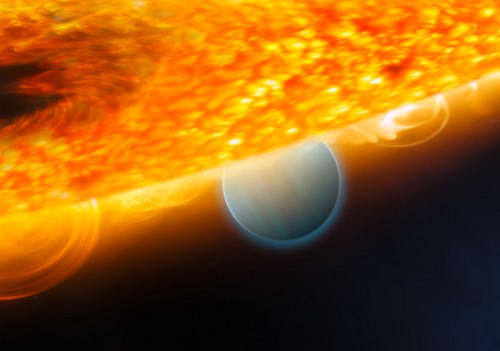Seems that some aliens might be having a global warming problem. The Hubble Space Telescope has discovered carbon dioxide in the atmosphere of a planet orbiting another star. This is an important step along the trail of finding the chemical biotracers of extraterrestrial life, as we know it.

The Jupiter-sized planet, called HD 189733b, is too hot for life. But new Hubble observations are a proof-of-concept demonstration that the basic chemistry for life can be measured on planets orbiting other stars. Organic compounds can also be a by-product of life processes and their detection on an Earth-like planet may someday provide the first evidence of life beyond Earth.
Previous observations of HD 189733b by Hubble and the Spitzer Space Telescope found water vapour. Earlier this year Hubble found methane in the planet’s atmosphere.
“This is exciting because Hubble is allowing us to see molecules that probe the conditions, chemistry, and composition of atmospheres on other planets” says first author Mark Swain of The Jet Propulsion Laboratory in Pasadena, USA. “Thanks to Hubble we’re entering an era where we are rapidly going to expand the number of molecules we know about on other planets”
The international team of astronomers used Hubble’s Near Infrared Camera and Multi-Object Spectrometer (NICMOS) to study infrared light emitted from the planet, which lies 63 light-years away. Gases in the planet’s atmosphere absorb certain wavelengths of light from the planet’s hot glowing interior. The team identified not only carbon dioxide, but also carbon monoxide. The molecules leave their own unique spectral fingerprint on the radiation from the planet that reaches Earth. This is the first time a near-infrared emission spectrum has been obtained for an extrasolar planet.
“The carbon dioxide is kind of the main focus of the excitement, because that is a molecule that under the right circumstances could have a connection to biological activity as it does on Earth” Swain says. “The very fact that we’re able to detect it, and estimate its abundance, is significant for the long-term effort of characterizing planets both to find out what they’re made of and to find out if they could be a possible host for life”
This type of observation is best done for planets with orbits tilted edge-on to Earth. They routinely pass in front of and then behind their parent stars, phenomena known as eclipses. The planet HD 189733b passes behind its companion star once every 2.2 days. This allows an opportunity to subtract the light of the star alone (when the planet is blocked) from that of the star and planet together prior to eclipse), thus isolating the emission of the planet alone and making possible a chemical analysis of its “day-side” atmosphere.
In this way, Swain explains that he’s using the eclipse of the planet behind the star to probe the planet’s day side, which contains the hottest portions of its atmosphere. “We’re starting to find the molecules and to figure out how many of them there are to see the changes between the day side and the night side,—Swain says.
This successful demonstration of looking at near-infrared light emitted from a planet is very encouraging for astronomers planning to use the NASA/ESA/CSA James Webb Space Telescope when it is launched in 2013. These biomarkers are best seen at near-infrared wavelengths.
Astronomers look forward to using JWST to spectroscopically look for biomarkers on a terrestrial planet the size of Earth, or a “super-Earth” several times our planet’s mass.
Swain and colleagues next plans to search for molecules in the atmospheres of other extrasolar planets, as well as trying to increase the number of molecules detected in extrasolar planet atmospheres. He also plans to use molecules to study changes that may be present in extrasolar planet atmospheres to learn something about the weather on these distant worlds.
Co-author Giovanna Tinetti from University College London adds: “In the terrestrial planets of our solar system, carbon dioxide plays a crucial role for the stability of climate. On Earth, carbon dioxide is one of the ingredients of the photosynthesis and a key element for the carbon cycle. Our observations represent a great opportunity to understand the role of carbon dioxide in the atmospheres of hot Jupiter type planets”.